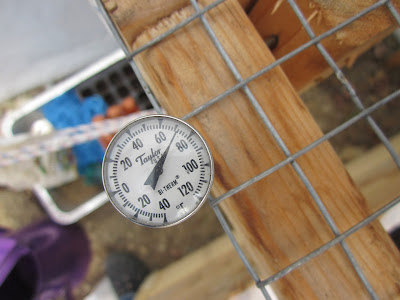I have talked many a time about our small greenhouse. While I am no expert on the matter, I have discovered through trial and error some of what can and can't be achieved in 80 square feet of unheated structure. Last year was my first year utilizing it and while it wasn't a complete bomb it was no where near what I would call a success. I did manage to grow some very wild and tall tomato plants but was able to harvest less than a pound of useable fruit despite 18 plants. Most of my problem was too shallow a box and not enough diligent watering and feeding which resulted in blossom end rot. Lesson learned and I won't do that again! My peppers were a better out come but I am certain the harvest could have been at least double what it was. So, when I cleaned up the boxes in the fall I really didn't have any specific plans for the next spring but I knew I wanted to make better use of this investment. Over the winter I researched (duh!) what could be grown in an unheated greenhouse an what if any tricks could be used to make it a success. Most were vague and rather unhelpful. Details my fellow bloggers, details! Well, here are my rules for growing in the small unheated greenhouse.
Rule #1: Plan. On paper. Measure your interior dimensions and then decide how much space you want for prep, seedling holding area, raised beds and even hanging plants. Then decide what you would like to eat and choose varieties that will work best for you. If you like greens an unheated greenhouse is the perfect way to get a good months jump on an early harvest. In fact we just had our first baby kale for dinner on Tuesday this week! Peas can be a great hardy spring vegetable to get in early as well and by planting it against the wall of your structure you can easily train it to climb up and out of the way on some string or even chicken wire. Depending on your own priorities I would advise thinking about succession planting to keep a continual harvest going. Some early vegetables will bolt or just stop thriving once the heat comes though so make sure you are well educated on each variety so you don't tie up valuable real estate for a worthless harvest. Spinach is one such vegetable and while it has grown fast and I have been tempted to seed some more I have decided to wait til fall to plant another crops worth because the description specifically advises against letting it grow during warmer temperatures.
Rule #2: If you have raised beds... cover them up with a board or old blankets or something at the end of the year. If you don't and there is a cat within a 5 mile radius he will find that soft, loose, perfect soil. And, he will shit in it. Ask me how I know?
Rule #3: Don't be fooled by the size, it's still a garden and it still takes work. You shouldn't ignore your greenhouse for more than a day in the spring and never ignore it in the summer. Those little beds can loose a lot of moisture just from evaporation and in the heat a greenhouse can get pretty steamy. The moisture in the air is not benefiting your plants! So water as often as it takes to keep the soil moist no less than an inch below the surface and keep the door, windows and even the bottom of the sides open as soon as the nights stay around 50 degrees. Air flow prevents moisture loving diseases and insects from taking over as well as regulates the temperature so even heat loving plants don't get heat stroke. Water either both morning and night or water deep in the morning before the sun is high so the water has a chance to seep down so it won't just evaporate off the surface.
Rule #4: If using for a nursery for tender warm weather crops, WATCH THE WEATHER. Nothing makes you want to cry as much as coming out one chilly morning to discover all of your lovingly cared for seedlings are darkened with frost bite and dead. Older plants may possibly be saved if you very gently water them before the sun hits them but the very small ones can't be saved. That being said, I would also advise not to plant an entire packet in case such an event does happen especially if you special ordered that variety. If you don't think you can remember, don't put your tender plants in there until you are a week or two past your areas last frost date. Our last frost date was May 2nd and I have just brought my peppers and tomatoes out to get better sun in the greenhouse. We have been having cool but relatively mild nights and mornings so I will watch the weather but I think I should be in the clear. My brother will appreciate having his sunny kitchen table back.
Rule #5: Be creative! Just because you have a small space doesn't mean you can't get a great harvest. All it takes is some creative space management (like a wire table above raised beds to allow light through but space to nurse seedlings or do some potting), and proper plant selection. The 36 spinach plants fit easily into a 2'x3' bed and will provide us with cut and come again harvesting until they show signs of bolting. By then the Rainbow chard and kale should be large enough to start picking off of and the perpetual spinach should be right behind (after I plant it!). Peas should be ready for harvest sometime in June (though I don't expect them to give a large amount).
All the rules being said, a lot of this you may just need to learn for yourself! Gardening can be taught all day but to really learn you must do. If you live in Maine or a similar climate I would highly encourage having some kind of greenhouse or even just a cold frame to get a jump on the short growing season and lengthen it in the fall. I would like to try wintering over some kale and chard to get an even bigger jump on next year as I have read if you hack them almost to the soil line before the deep freeze and cover well they will start growing again as soon as the temps are above freezing during the day (so when the sap starts running in the maples!)
I will be seeding perpetual spinach in one of the empty beds (two were left empty after I thinned and replanted everything). In the other one I am not sure what to do yet! I may sow some beets or maybe the onions. Whatever I do I need to decide ASAP! For now lets end the post with a couple more pictures...
Til next time, garden happy!
And then...












Thank you for taking the time to offer these hints. I am seriously considering getting one of these greenhouses because our plants are off to a lousy start. I'm not even sure we'll have any to speak of. With this post, at least I know what I'm in store for once I get rolling. Thanks!
ReplyDeleteJay
You are most welcome! We ordered ours from Tractor Supply but I'm sure you can find one similar online or at a home improvement store. Just be sure to add extra tie downs, the wind catches ours like a sail!
DeleteThanks for sharing last week on Green Thumb Thursday! I have featured this fabulous post. I hope you will join us again.
ReplyDeleteThank you!
Delete